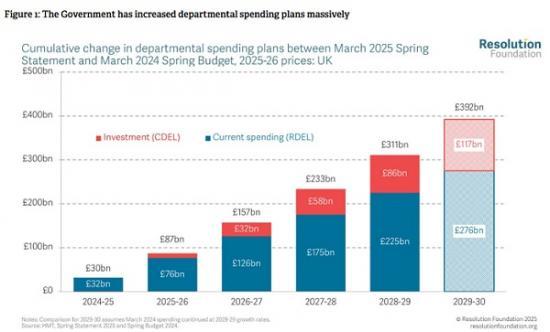Mission impossible? Five things to look out for at next week's pivotal Spending Review
5th June 2025

After a shaky start on the economy, Ministers have been happy to emphasise three trade agreements and some better-than-expected growth in recent weeks.
They will hope the Spending Review (SR), on 11 June, can be a chance to build (build, build) on this, and to flesh out more concrete plans on the Government's other ‘missions'.
Having spent the best part of a year managing expectations down and announcing painful tax rises and more borrowing, the Government finally gets to reap the benefits of dishing out some spending goodies. So this is a big deal politically.
But, as the first ‘zero-based' review in 17 years, it is also a big deal for the country with spending priorities set for the rest of this Parliament.
The hype around the SR has been of a return to austerity, but the reality is that the Government has pencilled in nearly £400 billion more in spending since the election. But how this SR feels inevitably comes down to health, with the size of its settlement mattering for every other department.
If NHS day-to-day spending was to increase by 2 per cent a year in real terms over the SR period, rather than the long run average of 3.6 per cent, that would free up around £11 billion to spend elsewhere. Not blowing the budget on health would also allow the Government to prioritise important ‘in kind' benefits from public services that materially affect families' day-to-day lives, and spending more on services used by poorer families would provide a material and popular boost to those struggling most with the cost of living.
Likewise on investment, where the SR will give more details on how the Government will spend its over £100 billion increase in planned projects, there's an opportunity to boost growth but also make a tangible difference to the housing crisis by investing in more affordable homes.
Some decisions are small in the overall fiscal arithmetic but will be particularly important for living standards. Free school meals provision directly affects poverty rates. Employment support can work at boosting employment rates - a key driver of living standards, so let’s see whether the Government sticks to its back-loaded ‘cuts before support’ approach. The SR also provides an opportunity to put on a permanent footing the crisis support provided through the Household Support Fund.
The bad news is that higher trade uncertainty and interest rates mean that the SR is taking place outside the fiscal reality in which those factors have likely wiped out the Chancellor’s ‘headroom’ at the Spring Statement.
Although it was not the original plan, the Government could also choose to set out further details on changes to its Winter Fuel Payment policy, and pay for it through lower departmental settlements. Or it could pile that too into the Chancellor’s fast growing autumn in-tray.
Let’s be honest: when it comes to the economy, the past 11 months have hardly been the start the Government was hoping for. Growth slowed in the second half of last year, confidence slipped, financial markets have been jittery, and Donald Trump’s tariffs are the new headwind that nobody needed.
Since the election, all voters have heard is how difficult the fiscal inheritance is, with painful announcements on higher borrowing and the biggest tax-raising Budget on record. But, with a week to go to the SR, as Rachel Reeves finalises the haggling with Cabinet Colleagues, the good news is that she can now say the Government has concluded three trade agreements, got some growth, and can finally dish out some spending goodies.
As shown in Figure 1, spending plans have been massively increased since Labour came to power last July, with nearly £400 billion more in departmental spending compared with plans made under the Tories (departmental spending has already risen by £87 billion in 2024-25 and 2025-26, with most of the detail of a further £305 billion of spending between 2026-27 and 2029-30 to be set out next Wednesday 11 June 2025).
Rad the full report HERE
